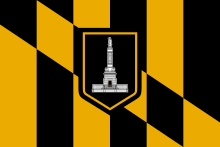Robert McLane
Robert Milligan McLane (November 30, 1867 – May 30, 1904) was the 32nd Mayor of Baltimore, serving from May 19, 1903 to his death on May 30, 1904. He is known for his role in the Great Baltimore Fire, and for his sudden death in office.
Robert McLane | |
|---|---|
 | |
| 32nd Mayor of Baltimore | |
| In office May 19, 1903 – May 30, 1904 | |
| Preceded by | Thomas Gordon Hayes |
| Succeeded by | E. Clay Timanus |
| Personal details | |
| Born | November 30, 1867 Baltimore, Maryland, U.S. |
| Died | May 30, 1904 (aged 36) Baltimore, Maryland, U.S. |
| Political party | Democratic |
| Spouse(s) | Mary Lusby Van Bibber |
| Relatives | Robert Milligan McLane (uncle) |
Early life
Robert McLane was born in Baltimore, the son of James Latimer and Fanny (King) McLane. He was the nephew of Robert Milligan McLane.[1] He graduated from Johns Hopkins University in 1886, and subsequently attended the University of Maryland School of Law.[1]
On May 14, 1904, he married Mrs. Mary (Lusby) Van Bibber, a widow several years his senior. She had been previously married to Dr. John Pierre Van Bibber, a Baltimore physician who had died in 1892.
Political career
In 1903, McLane was elected Mayor of Baltimore; he was 35, and the city's youngest mayor.[2] His actions in office included the appointment of William Cabell Bruce to the position of city solicitor,[3] and, far more controversially, the management of the Great Baltimore Fire in February 1904: during the fire, McLane "stood in the streets (...) cheering on the firefighters", which historian and professor of management Peter Petersen has described as "the macho thing to do", but "not the smartest", since it meant that McLane was incommunicado, and could not accept offers of aid from other cities.[2] In the fire's aftermath, McLane told the Baltimore News that although he was "gratified at the sympathy and the offers of practical assistance" from across the United States, "Baltimore [would] take care of its own people the best it can"; all donations were returned.[4]
Death
On May 30, 1904, McLane was found in his home, dying of a gunshot wound to the head.[5] He had been in office 385 days.[4]
McLane's death was ruled suicide.[5] Those who knew him had differing opinions as to this verdict, with some emphasizing the stress that he had faced as a result of the post-fire reconstruction.[5] In 2004, researchers from the Baltimore Sun pointed out that McLane had gotten married two weeks before his death, which could have alleviated his stress, but that his family had refused to attend the wedding because his wife was 12 years older than him and from the wrong social class ("the smart set" as opposed to "the retiring aristocratic sort"), which could have exacerbated it.[6] They also pointed out that McLane left no suicide note, and that he had written a letter earlier that day describing his plans for the following week.[6] In 1986, Sun columnist Theo Lippman, Jr. cited a 1956 letter to the editor which claimed that "many of us feel confident that we know that [McLane] was murdered and also who the murderer was and also the motive for that crime", but which did not provide further details.[5]
By 1914, the intersection of Baltimore Street and Liberty Street had been renamed McLane Place in his honor; however, this name was subsequently abandoned.[7]
References
- Mayor and City Council of Baltimore v. Baltimore and Philadelphia Steamboat Company, 65 A. 353, 104 Md. 485 (Dec. 19, 1906), by Russell K. George, at the University of Maryland Francis King Carey School of Law's Legal History of Maryland Project; published January 2004; retrieved December 26, 2016
- A Howling Inferno: The Great Baltimore Fire: Professor Delves into the City's Worst Disaster, at Johns Hopkins University; published January 12, 2004; retrieved December 26, 2016
- Archives of Maryland (Biographical Series) : William Cabell Bruce, at the Maryland State Archives; published October 3, 2001; retrieved December 26, 2016
- After The Fire, by Jim Duffy, published in Baltimore, February 2004; archived online at DuffyWriter.com; retrieved December 26, 2016
- Mayor's death, blaze still linked in mystery (page 3), by Scott Calvert, in the Baltimore Sun; published February 7, 2004; retrieved December 26, 2016
- Mayor's death, blaze still linked in mystery (page 2), by Scott Calvert, in the Baltimore Sun; published February 7, 2004; retrieved December 26, 2016
- Corner of Baltimore and Liberty Streets in 1914, at GhostsOfBaltimore.org; published April 14, 2015; retrieved December 26, 2016
